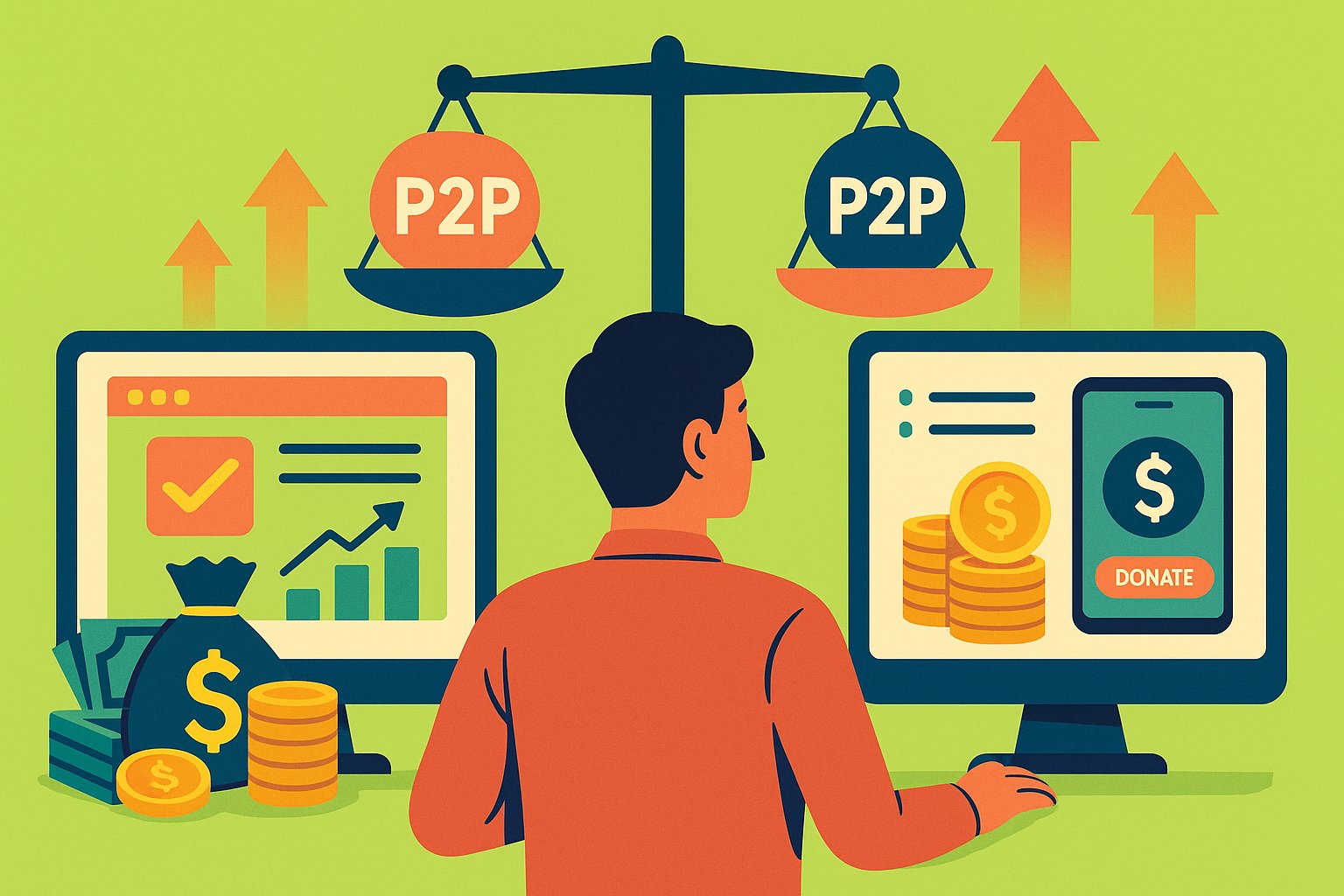Navigating the Digital Lending Frontier
The rise of peer-to-peer (P2P) lending has given investors a novel avenue to earn attractive yields by directly funding loans for individuals and small businesses. No longer confined to traditional banking or impersonal bond markets, P2P platforms allow everyday investors to participate in consumer and commercial credit with greater transparency and potentially higher returns. However, this democratization of credit comes with critical decisions: each platform differs in its underwriting standards, fee structures, user interfaces, and risk profiles. Selecting the right platform is akin to choosing the best foundation for a high-rise—it demands careful evaluation, an eye for detail, and a strategy that aligns with personal risk tolerance and financial goals. In this guide, we uncover the essential factors to consider when choosing the best P2P lending site, empowering investors to make confident, well-informed decisions that pave the way for sustainable success.
Peering into Platform Integrity
A platform’s credibility forms the bedrock of any P2P lending experience. Before committing capital, scrutinize the company’s history, leadership team credentials, and track record in matching borrowers to lenders. Look for platforms that publish detailed performance statistics—such as historical default rates, loan amortization schedules, and portfolio-wide returns—so you can verify self-reported data against independent sources when possible. Transparency extends beyond numbers; credible sites openly share underwriting methodologies, credit-scoring algorithms, and borrower verification processes. Many leading platforms collaborate with third-party auditors to validate their data and reinforce investor trust. Recognize that a platform’s willingness to expose vulnerabilities—such as acknowledging periods of elevated delinquencies—demonstrates integrity. By choosing a platform with a transparent framework, you mitigate the chance of encountering sudden policy changes or undisclosed risks that could erode your principal.
Mapping Out Loan Diversity
Not all loans are created equal. Some platforms focus on consumer credit—such as debt consolidation, medical financing, or education loans—while others cater to small business lending, real estate financing, or niche verticals like sustainable energy projects. Examining the loan spectrum is crucial for adequate diversification. Platforms that offer multiple categories and grades of loans enable investors to tailor their portfolios according to risk appetite. For instance, diversifying across unsecured personal loans, secured real estate debt, and small-business lines of credit can significantly reduce the impact of concentrated defaults. Additionally, check whether a platform supports fractional lending, which allows you to invest in small increments (e.g., $25 or $50) per loan. Fractional investment lowers barriers to entry and facilitates a broader spread of exposure. By selecting a platform with a robust mix of loan types and flexible investment minimums, you position yourself to build a resilient, well-balanced lending portfolio.
Calculating Returns and Costs
A glowing headline yield rarely tells the full story. To assess potential earnings accurately, investigate both the advertised returns and the fee structures that chip away at gross interest. Platforms typically charge investors a service or servicing fee—often ranging from 0.25% to 1% of loan payments—that covers payment processing, borrower management, and investor reporting. Some platforms may impose additional charges for withdrawing funds or accessing certain analytics tools. Contrast fee schedules across multiple sites to understand how net yields compare after costs. Simultaneously, analyze average interest rates offered for different loan grades—prime borrowers may pay 5% to 8% APR, while subprime borrowers could pay upwards of 20%. By modeling a few sample portfolios (e.g., 60% prime-grade, 40% subprime-grade) and subtracting known fees, you’ll arrive at a realistic estimate of net returns. This careful financial accounting ensures that you do not fall for attractive but unsustainable “up to X%” promises that obscure fee impact.
Safeguarding Against Loan Defaults
No matter how compelling the yields, loans carry an inherent risk: borrowers may default, delaying or forfeiting payments. Platforms mitigate this exposure through credit grading, risk-based pricing, and, in some cases, reserve funds or buyback guarantees. Examine each platform’s approach to underwriting: Do they perform comprehensive credit checks, income verification, and fraud scans? Are borrowers required to demonstrate collateral or co-signers? Some innovative sites leverage advanced data analytics and alternative credit signals—like social media behavior or utility payment histories—to refine risk assessments. Additionally, platforms that establish reserve pools—funds set aside to cover losses—offer a layer of protection when defaults exceed expectations. Note, however, that reserve mechanisms vary widely; some deduct a small percentage of each loan’s principal and interest to seed the reserve, while others rely on institutional backers. By understanding the nuanced strategies platforms use to address loan defaults, you can weigh whether the promised protection aligns with your desired risk level, ensuring that isolated borrower failures do not derail your entire investment.
Exploring User Journeys and Tech Tools
The best P2P lending sites shine not just through robust financial metrics but also through intuitive user experiences and powerful technological features. A streamlined onboarding process—featuring quick identity verification, straightforward risk disclosures, and guided tutorials—reduces friction and accelerates your entry into the lending ecosystem. Examine the platform’s dashboard capabilities: can you easily filter loan listings by credit grade, term length, or industry sector? Do interactive dashboards update in real time, highlighting payment statuses, returns-to-date, and portfolio diversification metrics? Some sites even offer mobile apps that send push notifications for newly listed loans matching your criteria or alert you when borrower payments post. While bells and whistles can be enticing, prioritize functionality over flashiness: ensure that key features—like auto-invest settings, withdrawal requests, and tax document downloads—operate seamlessly. A user-centric platform will foster greater engagement, enabling you to adapt strategies on the fly and avoid missing prime lending opportunities.
Weighing Support and Social Proof
Behind every reputable P2P platform stands a community of investors, borrowers, and support professionals whose interactions shape the lending environment. Browse online forums, social media groups, and independent review sites to gauge user sentiment regarding customer service responsiveness, dispute resolution, and technical reliability. Pay close attention to recurring themes: do multiple users praise a platform’s quick support for account lockouts or report slow responses to payment discrepancies? Platforms that invest in robust, multichannel support—via live chat, email, and phone—demonstrate commitment to user satisfaction. Additionally, explore the platform’s community forums or webinars, if available. Educational resources—such as blog posts, podcasts, or live Q&A sessions—help foster a collaborative ecosystem where investors can learn from experienced peers. This social proof not only aids your due diligence but also cultivates a sense of belonging, which can be invaluable when navigating uncharted lending scenarios or seeking advice on risk management tactics.
Ensuring Compliance and Data Safety
As financial intermediaries, P2P lending platforms must adhere to stringent regulatory frameworks and data protection standards. Confirm that each platform operates under the jurisdiction of reputable financial authorities—such as the Securities and Exchange Commission (SEC) in the United States or the Financial Conduct Authority (FCA) in the United Kingdom. Regulatory oversight ensures that platforms maintain capital adequacy, perform periodic audits, and comply with anti-money laundering (AML) and know-your-customer (KYC) policies. Simultaneously, evaluate the platform’s cybersecurity posture: does it employ bank-level encryption, multi-factor authentication, and regular security audits? Data breaches can not only jeopardize personal information but also halt platform operations, leaving investors unable to manage loans or withdraw proceeds. Reliable sites often publish transparency reports detailing security protocols and share updates when they undergo penetration testing or undergo third-party compliance reviews. By prioritizing regulatory compliance and rigorous data safeguards, you protect both your financial assets and personal privacy, laying the groundwork for a secure P2P lending journey.
Crafting a Comparative Lens
After gathering insights into platform integrity, loan diversity, fee structures, risk mitigation, user experience, community reputation, and compliance, it is time to compare your shortlisted options side by side. Build a straightforward comparison matrix that captures key metrics: average historical returns by loan grade, default rates over the past five years, minimum investment amounts, servicing fees, available auto-invest criteria, and the presence (or absence) of reserve funds or buyback guarantees. While spreadsheets can provide clear numerical comparisons, complement them with qualitative notes—such as unique educational resources, mobile app capabilities, or soft benefits like referral bonuses. Be mindful of platform lifecycles: newer sites may offer promotional sign-up incentives but lack a long-term track record. Conversely, stalwart platforms with decade-long histories might charge slightly higher fees but deliver greater predictability. By consolidating quantitative and qualitative data into a unified framework, you can visualize trade-offs more effectively and identify the platform whose cumulative strengths align best with your investment philosophy.
A Blueprint for Choosing Wisely
The final selection process distills your research into actionable decision-making. Start by revisiting your own investment objectives: Are you seeking steady but moderate returns, or willing to accept higher default risk for the chance of outsized yields? If preserving capital is paramount, prioritize platforms with strong underwriting criteria and reserve funds, even if average returns skew towards the lower end of the P2P spectrum. If you can tolerate some volatility and desire maximum income, select platforms known for high-yielding, subprime loan offerings—but counterbalance with a robust auto-invest strategy to dilute risk. Factor in non-financial considerations as well; perhaps a platform’s commitment to social impact—for example, lending to underserved communities—resonates with your personal values. Finally, test your reasoning by committing a small initial capital allocation—enough to confirm that platform operations meet your expectations but not so large as to threaten your broader portfolio’s balance. This deliberate pilot phase allows you to experience real-time performance, customer service responsiveness, and the accuracy of advertised data, unlocking critical insights before scaling up.
Harvesting the Rewards of an Informed Choice
Selecting the best peer-to-peer lending site is more than an exercise in comparing interest rates; it requires a holistic evaluation that balances financial returns, risk mitigation, platform credibility, user experience, and regulatory safeguards. When you invest time in due diligence—piecing together performance data, dissecting fee schedules, and probing underwriting practices—you not only optimize for potential earnings but also cultivate confidence that your capital rests on a sturdy digital foundation. Over time, as loan payments flow back into your account and reinvestment strategies compound your gains, you maintain clarity about the platform’s true value. Whether you’re a newcomer seeking passive income or a seasoned investor diversifying beyond traditional fixed-income products, the right P2P platform can become a reliable pillar in your financial portfolio. By following the blueprint outlined above, you position yourself to navigate the ever-evolving lending frontier with assurance—turning credit markets into accessible pathways to sustainable wealth generation.
Alighting on Your Ideal Platform
In the world of peer-to-peer lending, opportunity and responsibility coexist. While P2P platforms open doors to attractive yields, they also demand a discerning eye to identify potential pitfalls and biases. By approaching your selection process with intellectual curiosity, rigorous analysis, and a willingness to adapt as market conditions shift, you ensure that your choice stands the test of time. Regularly revisit performance metrics, stay abreast of industry innovations—such as decentralized finance initiatives or evolving AI-driven credit models—and remain engaged with community discussions about emerging risks and opportunities. Ultimately, the best peer-to-peer lending site for investors is the one that integrates seamlessly with your financial goals, aligns with your risk tolerance, and fosters a transparent, supportive community. As you embark on this journey, remember that informed choices today lay the groundwork for tomorrow’s financial resilience, transforming P2P lending from a novel experiment into a cornerstone of your long-term investment strategy.




